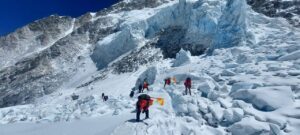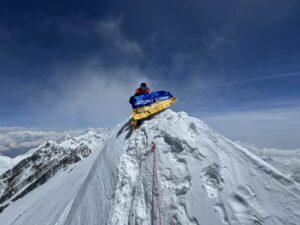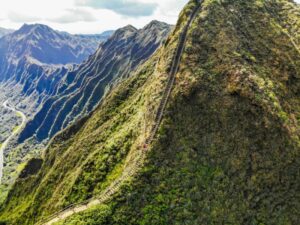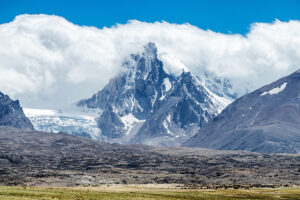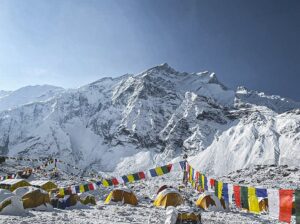This spring’s Himalayan season has put mountaineering back on mainstream media’s radar, but as usual, for all the wrong reasons. The NYT, Washington Post, CNN, the BBC and The Guardian have all decried the current state of Mount Everest, in the wake of 11 deaths and one viral photo.

It’s been extremely busy on Everest’s south side. Photo: Nirmal Purja/Project Possible
It has certainly been a complicated season. There have been summits on a variety of tricky peaks, dramatic rescues, new route attempts, and crowded retreads on Everest. Let’s recap.
Everest
The roof of the world has never been busier, but Nirmal Purja’s photo of a clogged ridge near the summit of Everest got everyone’s attention. As with German mountaineer Ralph Dujmovits’ 2012 photo, the backlash started almost immediately. Are the queues responsible for preventable deaths? Who is to blame? The Nepalese government? Tour companies? The climbers themselves? There were 11 deaths on Everest this month, three more than during the infamous 1996 Everest disaster (but fewer than the 14 Sherpas who died when a serac collapsed in the Icefall in 2014). Most of this year’s fatalities have been on the busy south side; only two occurred on the Chinese side.
The season started slowly, with high winds and fresh snow. On the south side, the Icefall Doctors secured a route through the Khumbu icefall in early April. They reported good conditions, with only a few large crevasses requiring two horizontal ladders and roughly five vertical ladders.
The first clients rotated through the icefall up to Camp 1 and Camp 2 around April 15, with no issues. But the dreaded bottlenecks started to appear on steep sections as foot traffic increased later in the month.

Climbers wait their turn on a ladder in the Khumbu icefall. Photo: Carlos Garranzo
On April 20, 700kg of rope-fixing gear was deposited at Advanced Base Camp, and Sherpas set to work fixing the ropes above 6,400m. They struggled for every metre in high winds, while the commercial teams started acclimatization rotations. By May 1, the Sherpas had progressed to just below the rock buttress of the Geneva Spur at 7,600m. The next day, they reached the South Col and Camp 4, the final launching pad for summit pushes.
Ropes to the summit are typically fixed later in the season on the north side, and that pattern held this year. Deep snow on the North Col caused early problems, but by May 3, the Sherpas reached 8,300m.
At this point, Cyclone Fani shut down progress on both sides of the mountain. The high winds and big dumps of snow either blew away or destroyed tents at both the North Col and at Camp 2 on the south side. Fortunately, teams had taken shelter at lower altitudes, and no casualties occurred during this extreme weather event.
By May 7, winds had calmed enough for acclimatization runs to continue. However, blustery conditions above 8,000m held rope-fixing teams in check.

Camp 2 at 7.700m on Everest’s north side. Photo: @drjonkedski
It wasn’t until May 14 that a highly experienced eight-man Sherpa team reached the summit on Everest’s south side. Their northern counterparts had elected to return to Base Camp and were nowhere to be seen, creating some discontent among those waiting. So only those in Nepal were able to exploit the season’s first weather window.
In bluebird weather, the commercial climbers quickly followed the rope-fixing team. The next morning, as many as 113 clients summited. With the successes came the first casualties. On May 16, Seamus Lawless of Ireland slipped and fell somewhere near the Balcony at 8,300m. Reportedly, he unclipped from the rope to answer a call of nature. Then on May 17, an Indian climber was found dead in his tent at Camp 4.

A climber acclimatizes on the north side of Everest while waiting for Sherpas to finish fixing ropes to the summit. Photo: Furtenbach Adventures
Jet stream winds returned over the next three days, further delaying route-fixing on the north side and temporarily pausing the stream of summits in Nepal. On May 20, the winds eased. Once again, teams raced for the top.
This good weather was predicted to be fairly brief. Perhaps inevitably, considering the money and egos on the line, the top of the world experienced a huge congestion on May 22 and May 23. Traffic jams formed at both the Balcony and on the Hillary Step.
The death toll rose quickly, and wild reports started to filter down from clients on the mountain. Elia Saikaly sounded shell-shocked: “I cannot believe what I saw up there. Death. Carnage. Chaos. Lineups.” Ed Dohring described a “death race” to the summit. Oxygen tanks drained, as hordes of climbers jostled for a precious photo on the summit.
Most fatalities came on the descent, from either extreme fatigue or altitude sickness. The huge crowds and accompanying delays turned some hopefuls back, including David Göttler, climbing without O2. Göttler was just a couple of hundred vertical metres from the top when he turned around. He later said that he simply couldn’t risk getting caught in a death-zone logjam.

Climbers file past a dead body near the summit on Everest. Photo: Elia Saikaly
In Tibet, the rope-fixing team completed its toil on May 22, opening a less crowded route to the summit. Cory Richards and Esteban Mena were attempting to open a somewhat new line on this north side. But they progressed too slowly and eventually turned back on May 23, at around 7,600m, short on energy and with bad weather coming. They hope to try again next year.
The total tally this season surpasses 800 summits (south and north sides combined) and 11 deaths. Notable accomplishments include: Kami Rita Sherpa, who summited twice, increasing his own Everest record to 24; Elisabeth Revol, returning to the Himalaya after nearly losing her life on Nanga Parbat in 2018; Juan Pablo Mohr of Chile without oxygen; and Nirmal Purja as part of his ambitious project to summit every 8,000m peak in just seven months.
Now, as teams pack up their Base Camps, some are celebrating and some are grieving. Meanwhile, the wider community confronts what Everest has become and whether it needs to change.
Annapurna
Not to be outdone by Everest, Annapurna proved surprisingly busy and surprisingly undramatic, considering its fearsome death rate.
The once rarely climbed peak saw somewhat of an Everestification this season, with a strong Sherpa team beating a way to the summit in late April. Subsequently, a whopping 32 climbers topped out on April 23.

Rupert Jones-Warner approaches the summit of Annapurna. Photo: Don Bowie
Celebrations quickly ended when news arrived that one of the 32 went “missing” during his descent. Wui Kin Chin, a Malaysian anesthesiologist, became extremely weak after leaving the summit. His Sherpa, Nima Tshering, apparently had to give him the remaining oxygen and descend alone to Camp 4 to get help. The ensuing rescue featured delays, finger-pointing, confusion, and ultimately, Chin’s death in a Singapore hospital.
After the initial frenzy of summits, Annapurna’s weather appears to have closed in, foiling those who expected to climb later in the season, such as Adam Bielecki and Felix Berg, who hoped to open a new route on the peak’s Northwest Face. They had failed on the technical Langtang Lirung because of constant snowfall and the approaching monsoon. In the end, the power duo never made it to Annapurna.
Lhotse
On May 14, Everest’s nearest neighbour saw the first successful climbs of the season. Seven Sherpas from Imagine Nepal and five clients from China, Greece and Pakistan reached the 8,516m summit just hours before Sherpas opened the route on Everest.

David Göttler on the Lhotse Wall during his last acclimatization climb. Photo: David Göttler
The next day, four well-known independent mountaineers, Sergi Mingote and Carlos Garranzo of Spain, Ali Sadpara of Pakistan and Juan Pablo Mohr of Chile joined forces for the final section of the climb. They summited without supplementary oxygen and descended in worsening weather. Between Camp 4 and Camp 3, they ran into two stricken climbers, Bulgarian Ivan Tomov and Russian Nastya Runova. Mohr and Mingote improvised a stretcher and helped them down to Camp 2. Sadly, only Runova survived.
The last man standing, South Korean Hong Sung-Taek, is currently on Lhotse, taking a sixth crack at its South Face. Originally with a sizeable team, only Hong Sung-Taek and five climbing Sherpas now remain after a succession of avalanche scares sent most of the expedition packing. Hong and company hope to reach the summit of Lhotse on June 2.
Kangchenjunga
Another once-lonely mountain, Kangchenjunga saw an astonishing 50 summits this season.
As on Lhotse and Everest, Sherpas blazed a trail to the top, finishing on May 14. And as on Annapurna, there was almost immediately a rescue operation underway, in which Nirmal Purja and his team gave up their remaining oxygen to two struggling Indian climbers during their descent from the summit. Purja had already bagged Annapurna and Dhaulagiri and was no doubt weary, even before ceding his oxygen. The gesture was, unfortunately, in vain: Both climbers, Kuntal Karar and Biplab Baidya, perished of hypothermia above Camp 4. Baidya had reportedly made it to the summit; Karar collapsed before reaching it.

Hernán Leal atop Kangchenjunga. Photo: Hernán Leal
In one confusing episode, there was both success and tragedy for Chilean mountaineers on the mountain. Hernán Leal claimed to be the first Chilean to summit Kangchenjunga, but his countryman, Rodrigo Vivanco, may have beaten him to it on May 15, only to go missing above Camp 4 (7,550m) during his descent. A search operation was not reported, and he is presumed dead.
Makalu
Makalu has 25 summits this season, as well as its share of deaths.
Makalu’s season started ominously when, on May 8, Peruvian mountaineer Richard Hidalgo died in his tent at Camp 2.

Hidalgo was an International High Mountain Guide (UIAMG) and had climbed six of the 8000’ers. Photo: Richard Hidalgo
On May 16, an 18-member Indian Army team summited but lost a member to altitude sickness during their descent. Another Indian climber, Dipankar Ghos, went missing at 7,300m, and search efforts were unable to reach him in time. His remains have now been recovered.
Dhaulagiri
Horia Colibășanu, Marius Gane, and Peter Hámor had targeted the White Mountain’s unclimbed Northwest Ridge, without oxygen or Sherpa support. One of the few fresh routes attempted this season, the venture ultimately failed. From Base Camp at the beginning of April, they slowly worked their way up to 5,600m through a steep chimney and technical ice. Strong winds and continuing bad weather kept them from continuing. Like Cory Richards and Esteban Mena on Everest, they plan to continue working on their new route next year.

Just ask Carlos Soria how hard it can be to succeed on Dhaulagiri. The 80-year-old has tried nine times, most recently last year. Photo: YoSuboConCarlosSoria
Others were able to summit in May via the normal route, including the seemingly ever-present Nirmal Purja, who did it without supplemental oxygen.
Chamlang
In a rare bit of good news, the most remarkable climb of the season occurred on Chamlang, a 7,319m peak in the shadow of Makalu. Czechs Marek “Mara” Holeček and Zděnek “Hook” Hák opened a new route up the 2,000m Northwest Face, on an eight-day, alpine-style climb.
The Piolet d’Or winners are no strangers to remarkable climbs and could be in the conversation for another this year.

Marek Holeček and Zděnek Hák on Chamlang. Photo: Marek Holeček

